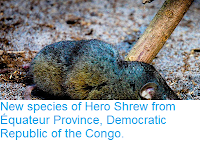Moonrats, Galericinae, are Rodent-like carnivorous Mammals closely related to Hedgehogs. They are found in the forests of Southeast Asia, and are thought to be of East Asian origin, appearing in the Eocene and probably being similar in form to the earliest Eulipotyphles (the group that also includes Hedgehogs, Shrews and Moles). They reached their maximum distribution during the Miocene, when they reached as far as Europe and Africa. One notable genus, Deinogalerix, is known from the Late Miocene of the Gargano Promontory in Central Italy (which was an island in the Miocene), where it underwent a local evolutionary radiation in the absence of other predators, producing a number of Cat- and Dog-like forms.
In a paper published in the journal Palaeontologica Electronica in April 2017, Andrea Savorelli of the Department of Earth Sciences at the University of Florence, Federico Masini of the Department of Earth and Marine Sciences at the University of Palermo, Paul Mazza, also of the Department of Earth Sciences at the University of Florence, and Maria Adelaide Rossi and Silvano Agostini of the Archaeological Superintendency of Abruzzo, describe a new species of Deinogalerix from the Late Miocene of Gargano.
The new species is named Deinogalerix samni, where 'samni' refers to the Samnites, the ancient inhabitants of the region. The species is described from two fragmental right maxillaries, two fragments of horizontal rami of left hemimandibles and a well preserved, isolated first molar. The specimens were all found in the collections of museums and universities and were identified as a new species during a review of the genus, based upon the size ratios of the molars and premolars of the specimens.
Deinogalerix samniticus, from Scontrone. (1)–(2) Fragment of left hemimandible, with p3, p4, alveoli of p2, broken m1, m2, and m3 partially embedded in the rock, (1) labial view, (2), occlusal view. (3)–(5) Isolated left first molar, (3) occlusal view, (4) labial view, (5), lingual view. (6)–(7) Fragmental right maxillary with complete P3 and fragmented P4, (6) occlusal view, (7) lingual view. (8) Fragmental right maxillary, with M3 and postero-lingual portion of M2. Savorelli et al. (2017).
See also...
Follow Sciency Thoughts on Facebook.





